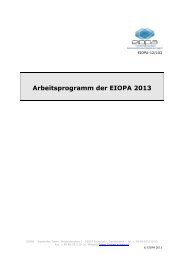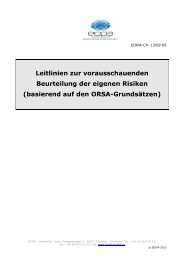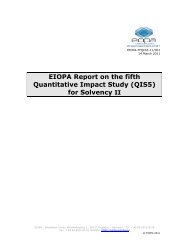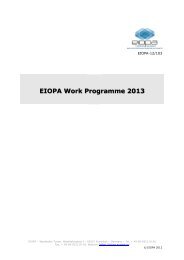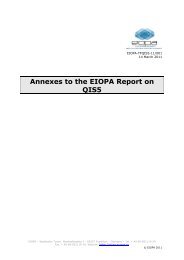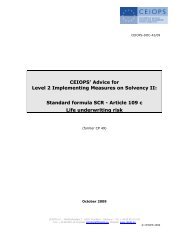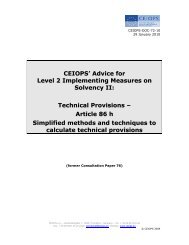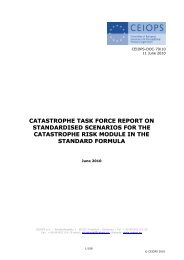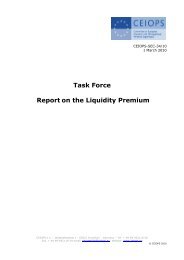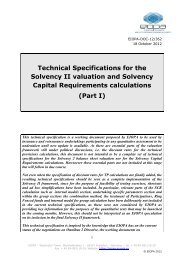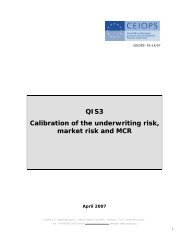Answers to the European Commission on the ... - Eiopa - Europa
Answers to the European Commission on the ... - Eiopa - Europa
Answers to the European Commission on the ... - Eiopa - Europa
You also want an ePaper? Increase the reach of your titles
YUMPU automatically turns print PDFs into web optimized ePapers that Google loves.
error in <str<strong>on</strong>g>the</str<strong>on</strong>g> calibrati<strong>on</strong> of <str<strong>on</strong>g>the</str<strong>on</strong>g> formula.<br />
Underwriting risk in life insurance<br />
10.140 CEIOPS recommends testing a multiple-fac<str<strong>on</strong>g>to</str<strong>on</strong>g>r based approach <str<strong>on</strong>g>to</str<strong>on</strong>g><br />
model underwriting risk as <str<strong>on</strong>g>the</str<strong>on</strong>g> base model, supplemented with simple<br />
scenario techniques.<br />
10.141 The fac<str<strong>on</strong>g>to</str<strong>on</strong>g>r-based model should address mortality risk and expense<br />
risk. Lapse risk might be captured ei<str<strong>on</strong>g>the</str<strong>on</strong>g>r by an additi<strong>on</strong>al risk fac<str<strong>on</strong>g>to</str<strong>on</strong>g>r,<br />
or by a pre-specified stress test. CEIOPS recommends testing <str<strong>on</strong>g>the</str<strong>on</strong>g>se<br />
two alternatives in QIS. However, CEIOPS notes that lapse risk needs<br />
<str<strong>on</strong>g>to</str<strong>on</strong>g> be addressed in <str<strong>on</strong>g>the</str<strong>on</strong>g> SCR <strong>on</strong>ly <str<strong>on</strong>g>to</str<strong>on</strong>g> <str<strong>on</strong>g>the</str<strong>on</strong>g> extent that it is not already<br />
captured by <str<strong>on</strong>g>the</str<strong>on</strong>g> treatment of surrender floors in technical provisi<strong>on</strong>s.<br />
10.142 With regards <str<strong>on</strong>g>to</str<strong>on</strong>g> mortality risk, a natural choice for a volume measure,<br />
subject <str<strong>on</strong>g>to</str<strong>on</strong>g> fur<str<strong>on</strong>g>the</str<strong>on</strong>g>r analysis, might be <str<strong>on</strong>g>the</str<strong>on</strong>g> technical provisi<strong>on</strong> at <str<strong>on</strong>g>the</str<strong>on</strong>g><br />
beginning of <str<strong>on</strong>g>the</str<strong>on</strong>g> solvency assessment time horiz<strong>on</strong> in cases where <str<strong>on</strong>g>the</str<strong>on</strong>g><br />
risk of l<strong>on</strong>gevity is relevant, and <str<strong>on</strong>g>the</str<strong>on</strong>g> capital at risk at <str<strong>on</strong>g>the</str<strong>on</strong>g> beginning of<br />
<str<strong>on</strong>g>the</str<strong>on</strong>g> solvency assessment time horiz<strong>on</strong> in cases where an increase in<br />
<str<strong>on</strong>g>the</str<strong>on</strong>g> mortality rate is relevant.<br />
10.143 Using a prospective valuati<strong>on</strong> approach of assets and liabilities means<br />
that all possible future cash flows will have <str<strong>on</strong>g>to</str<strong>on</strong>g> be identified and valued.<br />
Expenses that will have <str<strong>on</strong>g>to</str<strong>on</strong>g> be made in future <str<strong>on</strong>g>to</str<strong>on</strong>g> service an insurance<br />
c<strong>on</strong>tract are <strong>on</strong>e of those cash flows for which a provisi<strong>on</strong> will have <str<strong>on</strong>g>to</str<strong>on</strong>g><br />
be calculated. This provisi<strong>on</strong> might be a natural choice as a volume<br />
measure for expense risk.<br />
10.144 Lapse risk could be assessed by determining <str<strong>on</strong>g>the</str<strong>on</strong>g> impact of an<br />
appropriate change in lapse rates (for example doubling and reducing<br />
by <strong>on</strong>e-half).<br />
10.145 An assessment of underwriting risk requires underlying data that are<br />
sufficiently homogeneous with respect <str<strong>on</strong>g>to</str<strong>on</strong>g> emergence, development and<br />
statistical pattern of claims. Therefore <str<strong>on</strong>g>the</str<strong>on</strong>g> insurers’ book of business<br />
will need <str<strong>on</strong>g>to</str<strong>on</strong>g> be segmented in<str<strong>on</strong>g>to</str<strong>on</strong>g> homogeneous risk classes.<br />
10.146 The risk capital charges for each segment might be determined<br />
individually, before suitable aggregati<strong>on</strong> methods are applied <str<strong>on</strong>g>to</str<strong>on</strong>g> arrive<br />
at an overall risk capital charge. Alternatively, <str<strong>on</strong>g>the</str<strong>on</strong>g> overall risk capital<br />
charge might be determined from assumpti<strong>on</strong>s <strong>on</strong> <str<strong>on</strong>g>the</str<strong>on</strong>g> type of <str<strong>on</strong>g>the</str<strong>on</strong>g><br />
distributi<strong>on</strong> <strong>on</strong> <str<strong>on</strong>g>the</str<strong>on</strong>g> level of <str<strong>on</strong>g>the</str<strong>on</strong>g> diversified overall risk ra<str<strong>on</strong>g>the</str<strong>on</strong>g>r than <strong>on</strong><br />
<str<strong>on</strong>g>the</str<strong>on</strong>g> level of <str<strong>on</strong>g>the</str<strong>on</strong>g> segment risk. Such an approach would take <strong>on</strong>ly <str<strong>on</strong>g>the</str<strong>on</strong>g><br />
first two moments of <str<strong>on</strong>g>the</str<strong>on</strong>g> probability distributi<strong>on</strong> from <str<strong>on</strong>g>the</str<strong>on</strong>g> segment<br />
level in<str<strong>on</strong>g>to</str<strong>on</strong>g> account. CEIOPS recommends testing both alternatives in<br />
QIS.<br />
Underwriting risk in n<strong>on</strong>-life insurance<br />
10.147 CEIOPS recommends testing a fac<str<strong>on</strong>g>to</str<strong>on</strong>g>r-based approach <str<strong>on</strong>g>to</str<strong>on</strong>g> model<br />
underwriting risk as <str<strong>on</strong>g>the</str<strong>on</strong>g> base model, supplemented with simple<br />
108



